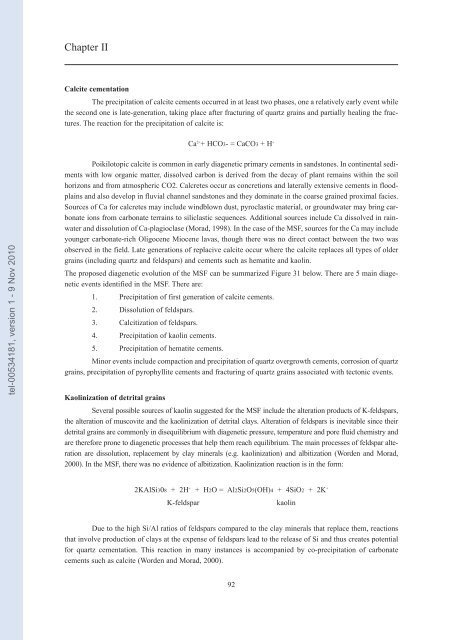Etude stratigraphique, pétrographique et diagénétique des grès d ...
Etude stratigraphique, pétrographique et diagénétique des grès d ...
Etude stratigraphique, pétrographique et diagénétique des grès d ...
Create successful ePaper yourself
Turn your PDF publications into a flip-book with our unique Google optimized e-Paper software.
tel-00534181, version 1 - 9 Nov 2010<br />
Chapter II<br />
Calcite cementation<br />
The precipitation of calcite cements occurred in at least two phases, one a relatively early event while<br />
the second one is late-generation, taking place after fracturing of quartz grains and partially healing the fractures.<br />
The reaction for the precipitation of calcite is:<br />
Ca 2+ + HCO3- = CaCO3 + H +<br />
Poikilotopic calcite is common in early diagen<strong>et</strong>ic primary cements in sandstones. In continental sediments<br />
with low organic matter, dissolved carbon is derived from the decay of plant remains within the soil<br />
horizons and from atmospheric CO2. Calcr<strong>et</strong>es occur as concr<strong>et</strong>ions and laterally extensive cements in floodplains<br />
and also develop in fluvial channel sandstones and they dominate in the coarse grained proximal facies.<br />
Sources of Ca for calcr<strong>et</strong>es may include windblown dust, pyroclastic material, or groundwater may bring carbonate<br />
ions from carbonate terrains to siliclastic sequences. Additional sources include Ca dissolved in rainwater<br />
and dissolution of Ca-plagioclase (Morad, 1998). In the case of the MSF, sources for the Ca may include<br />
younger carbonate-rich Oligocene Miocene lavas, though there was no direct contact b<strong>et</strong>ween the two was<br />
observed in the field. Late generations of replacive calcite occur where the calcite replaces all types of older<br />
grains (including quartz and feldspars) and cements such as hematite and kaolin.<br />
The proposed diagen<strong>et</strong>ic evolution of the MSF can be summarized Figure 31 below. There are 5 main diagen<strong>et</strong>ic<br />
events identified in the MSF. There are:<br />
1. Precipitation of first generation of calcite cements.<br />
2. Dissolution of feldspars.<br />
3. Calcitization of feldspars.<br />
4. Precipitation of kaolin cements.<br />
5. Precipitation of hematite cements.<br />
Minor events include compaction and precipitation of quartz overgrowth cements, corrosion of quartz<br />
grains, precipitation of pyrophyllite cements and fracturing of quartz grains associated with tectonic events.<br />
Kaolinization of d<strong>et</strong>rital grains<br />
Several possible sources of kaolin suggested for the MSF include the alteration products of K-feldspars,<br />
the alteration of muscovite and the kaolinization of d<strong>et</strong>rital clays. Alteration of feldspars is inevitable since their<br />
d<strong>et</strong>rital grains are commonly in disequilibrium with diagen<strong>et</strong>ic pressure, temperature and pore fluid chemistry and<br />
are therefore prone to diagen<strong>et</strong>ic processes that help them reach equilibrium. The main processes of feldspar alteration<br />
are dissolution, replacement by clay minerals (e.g. kaolinization) and albitization (Worden and Morad,<br />
2000). In the MSF, there was no evidence of albitization. Kaolinization reaction is in the form:<br />
2KAlSi308 + 2H + + H2O = Al2Si2O5(OH)4 + 4SiO2 + 2K +<br />
K-feldspar kaolin<br />
Due to the high Si/Al ratios of feldspars compared to the clay minerals that replace them, reactions<br />
that involve production of clays at the expense of feldspars lead to the release of Si and thus creates potential<br />
for quartz cementation. This reaction in many instances is accompanied by co-precipitation of carbonate<br />
cements such as calcite (Worden and Morad, 2000).<br />
92

















